Tritos
The tritos is an eclipse cycle of 3986.628 days. (about 1 month short of 11 years)

It corresponds to:
- 135 synodic months
- 146.50144 draconic months
- 11.50144 eclipse years (23 eclipse seasons)
- 144.68135 anomalistic months.
The length of the tritos is equal to the length of the inex minus the length of the saros eclipse cycles. Therefore, eclipses that occur 1 tritos apart (i.e. both eclipses belong to the same tritos series), belong to two different saros series with series numbers that differ by one.
The pre-Columbian Maya used a calculation in their own observations of eclipse cycles in which a period of three tritoses was approximated by 11960 days, based on 46 periods of their tzolk'in calendar (i.e. 46 × 260 days). The number of anomalistic months in a tritos (144.68), having a fraction near 2⁄3, means every third eclipse is in nearly the same position in the elliptical orbit, so eclipses will have similar timing and total versus annular quality.
Solar and lunar eclipse event dates will repeat on this cycle for about 700 years.
Example solar Tritos series
This eclipse is a part of a tritos cycle, repeating at alternating nodes every 135 synodic months (≈ 3986.63 days, or 11 years minus 1 month). Their appearance and longitude are irregular due to a lack of synchronization with the anomalistic month (period of perigee), but groupings of 3 tritos cycles (≈ 33 years minus 3 months) come close (≈ 434.044 anomalistic months), so eclipses are similar in these groupings.
| Series members between 1801 and 2100 | |||
|---|---|---|---|
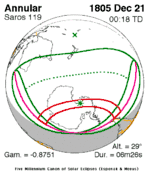 December 21, 1805 (Saros 119) |
 November 19, 1816 (Saros 120) |
 October 20, 1827 (Saros 121) | |
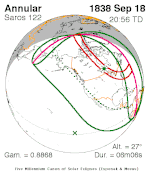 September 18, 1838 (Saros 122) |
 August 18, 1849 (Saros 123) |
 July 18, 1860 (Saros 124) | |
 June 18, 1871 (Saros 125) |
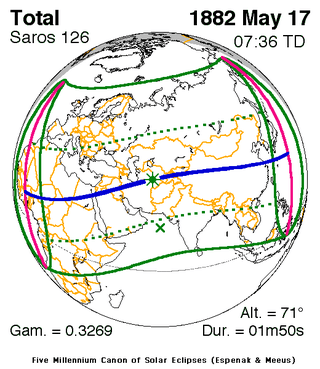 May 17, 1882 (Saros 126) |
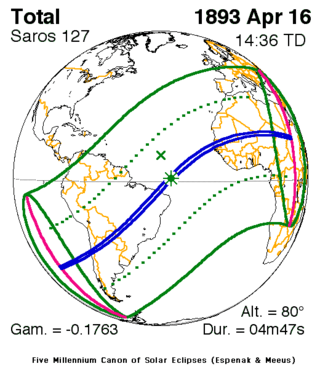 April 16, 1893 (Saros 127) | |
 March 17, 1904 (Saros 128) |
 February 14, 1915 (Saros 129) |
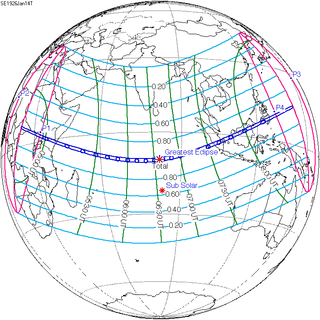 January 14, 1926 (Saros 130) | |
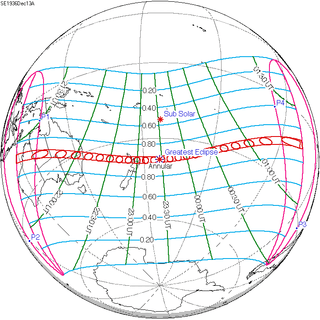 December 13, 1936 (Saros 131) |
 November 12, 1947 (Saros 132) |
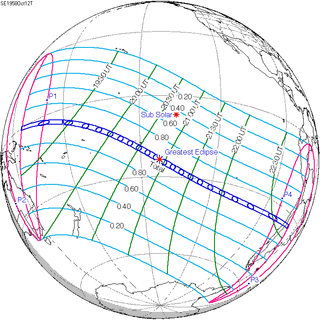 October 12, 1958 (Saros 133) | |
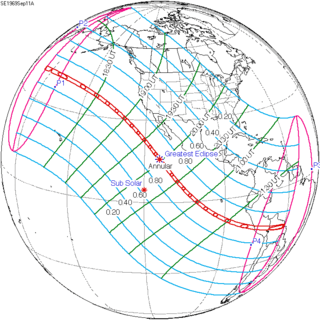 September 11, 1969 (Saros 134) |
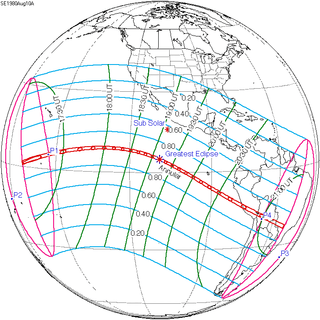 August 10, 1980 (Saros 135) |
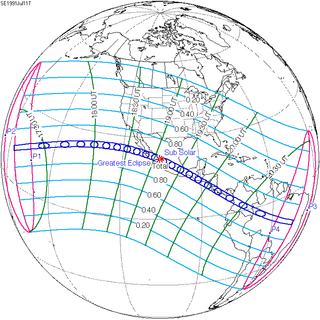 July 11, 1991 (Saros 136) | |
 June 10, 2002 (Saros 137) |
 May 10, 2013 (Saros 138) |
 April 8, 2024 (Saros 139) | |
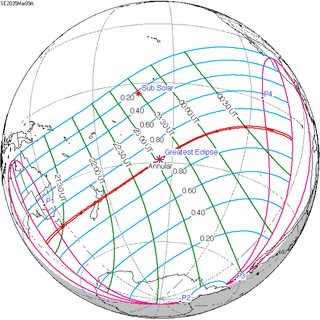 March 9, 2035 (Saros 140) |
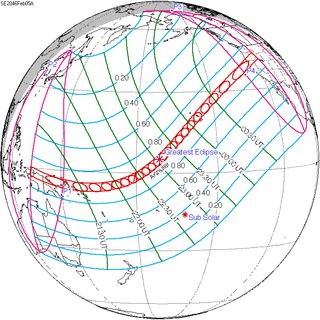 February 5, 2046 (Saros 141) |
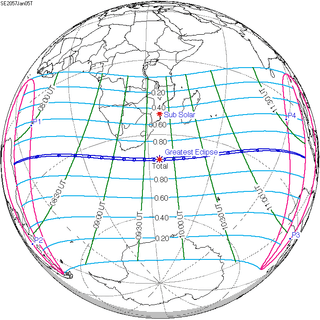 January 5, 2057 (Saros 142) | |
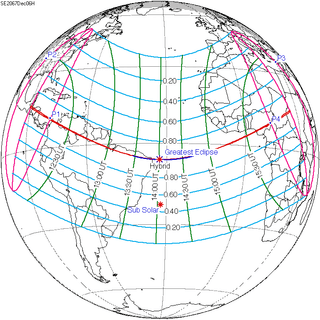 December 6, 2067 (Saros 143) |
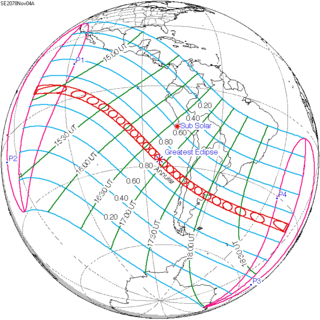 November 4, 2078 (Saros 144) |
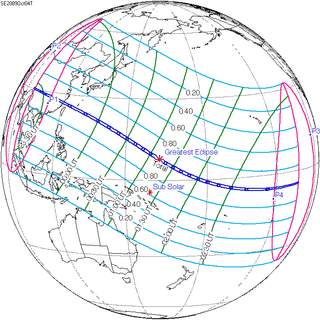 October 4, 2089 (Saros 145) | |
 September 4, 2100 (Saros 146) |
|||
In the 22nd century:
- Solar Saros 147: Annular Solar Eclipse of 2111 Aug 04
- Solar Saros 148: Total Solar Eclipse of 2122 Jul 04
- Solar Saros 149: Total Solar Eclipse of 2133 Jun 03
- Solar Saros 150: Annular Solar Eclipse of 2144 May 03
- Solar Saros 151: Annular Solar Eclipse of 2155 Apr 02
- Solar Saros 152: Total Solar Eclipse of 2166 Mar 02
- Solar Saros 153: Annular Solar Eclipse of 2177 Jan 29
- Solar Saros 154: Annular Solar Eclipse of 2187 Dec 29
- Solar Saros 155: Total Solar Eclipse of 2198 Nov 28
In the 23rd century:
- Solar Saros 156: Annular Solar Eclipse of 2209 Oct 29
- Solar Saros 157: Annular Solar Eclipse of 2220 Sep 27
- Solar Saros 158: Total Solar Eclipse of 2231 Aug 28
- Solar Saros 159: Partial Solar Eclipse of 2242 Jul 28
- Solar Saros 160: Partial Solar Eclipse of 2253 Jun 26
- Solar Saros 161: Partial Solar Eclipse of 2264 May 26
- Solar Saros 162: Partial Solar Eclipse of 2275 Apr 26
- Solar Saros 163: Partial Solar Eclipse of 2286 Mar 25
- Solar Saros 164: Partial Solar Eclipse of 2297 Feb 22
Example lunar Tritos series
The tritos series repeats 31 days short of 11 years at alternating nodes. Sequential events have incremental Saros cycle indices.
This series produces 23 total eclipses between June 22, 1880 and August 9, 2120.
| Ascending node | Descending node | |||||
|---|---|---|---|---|---|---|
| Saros | Date Viewing |
Type chart |
Saros | Date Viewing |
Type chart | |
| 120 | 1902 Apr 22 |
Total |
121 | 1913 Mar 22 |
Total | |
| 122 | 1924 Feb 20 |
Total |
123 | 1935 Jan 19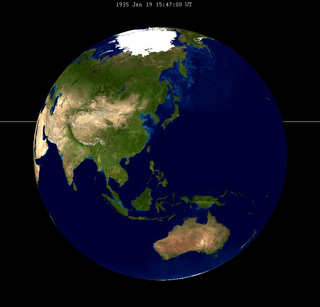 |
Total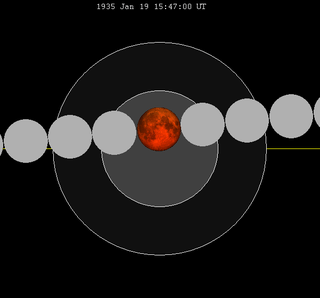 | |
| 124 | 1945 Dec 19 |
Total |
125 | 1956 Nov 18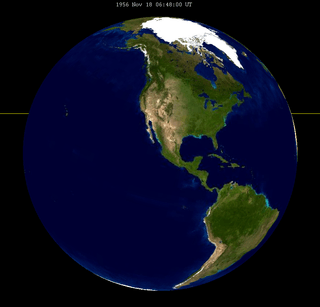 |
Total | |
| 126 | 1967 Oct 18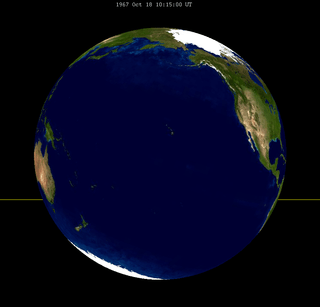 |
Total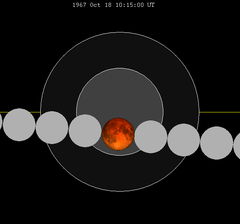 |
127 | 1978 Sep 16 |
Total | |
| 128 | 1989 Aug 17 |
Total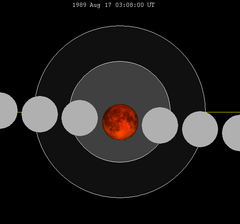 |
129 | 2000 Jul 16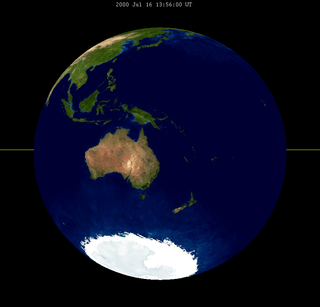 |
Total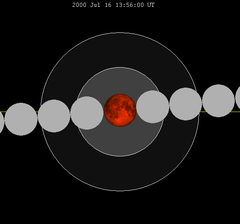 | |
| 130 | 2011 Jun 15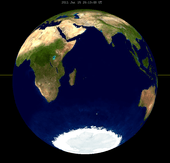 |
Total |
131 | 2022 May 16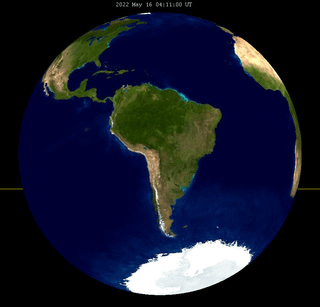 |
Total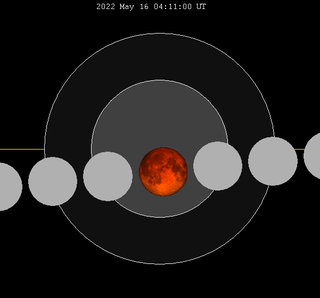 | |
| 132 | 2033 Apr 14 |
Total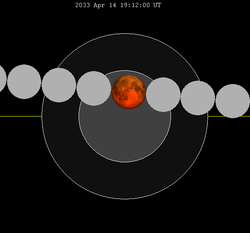 |
133 | 2044 Mar 13 |
Total | |
| 134 | 2055 Feb 11 |
Total |
135 | 2066 Jan 11 |
Total | |
| 136 | 2076 Dec 10 |
Total |
137 | 2087 Nov 10 |
Total | |
| 138 | 2098 Oct 10 |
Total | ||||
See also
- Eclipse cycle
- Inex - related series
References
- Mathematical Astronomy Morsels, Jean Meeus, Willmann-Bell, Inc., 1997 (Chapter 9, p. 51, Table 9.A Some eclipse Periodicities)